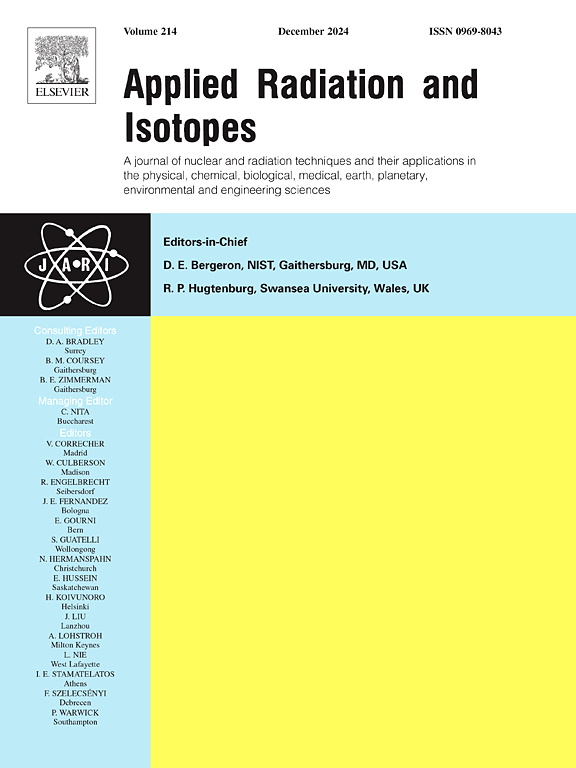骨盆直立造影前后位投影的比较
IF 1.6
3区 工程技术
Q3 CHEMISTRY, INORGANIC & NUCLEAR
引用次数: 0
摘要
目的骨盆x线检查是放射剂量最高、最常见的x线检查之一。因此,本研究探讨了是否可以使用后前位(PA)替代既定的前位(AP)投影来进行直立位盆腔x线摄影。方法在临床环境中对100例骨盆造影患者进行研究。患者随机分为两组,每组50人;第一组采用AP投影成像,第二组采用PA投影成像。测量每位患者的体重和身高,并以此计算体重指数。成像时,测量源到患者,并整理管电压、管电流和时间积、剂量面积积(DAP)、源到图像受体距离和初级视场大小。在此基础上,计算了入射表面剂量(ESD)和有效剂量,以及对选定器官的剂量。除了测量的剂量值外,图像质量也由三名经验丰富的放射科医生使用ViewDEX 2.57软件进行评估。结果勃起盆腔造影中DAP和ESD的AP和PA投影无统计学差异。另一方面,统计学差异为51.5% (p <;在比较有效剂量时发现0.001)。在AP投影中,在PA中拍摄的x线片的图像质量没有统计学上的显著差异。结论基于以上结果,我们可以得出结论,由于有效剂量明显降低,在进行骨盆勃起x线摄影时应选择PA投影方法。本文章由计算机程序翻译,如有差异,请以英文原文为准。
Comparison of anteroposterior and posteroanterior projection in erect pelvic radiography
Purpose
The X-ray examination of the pelvis is one of the procedures with the highest radiation dose and the most common X-ray examination. For this reason, this study investigated whether the alternative posteroanterior (PA) projection can be used instead of the established anteroposterior (AP) projection to perform pelvic radiography in an erect position.
Methods
The study was conducted in a clinical setting on 100 patients who were referred to erect pelvic radiography. The patients were randomly divided into two equal groups of 50; the first group was imaged in the AP projection, and the second group in the PA projection. Weight and height were measured for each patient, from which the body mass index was calculated. During imaging, the source-to-patient was measured, and the tube voltage, tube current and time product, Dose Area Product (DAP), source-to-image receptor distance, and primary field size were collated. Based on these data, the entrance surface dose (ESD) and the effective dose, as well as the dose to selected organs, were calculated. In addition to measured dosimetric values, image quality was also assessed by three experienced radiologists using ViewDEX 2.57 software.
Results
No statistically significant differences were found between the AP and PA projection of erect pelvic radiography for DAP and ESD. On the other hand, a statistically significant difference of 51.5 % (p < 0.001) was found when comparing the effective dose. There were no statistically significant differences between the image quality of the radiographs taken in the PA in AP projection.
Conclusion
Based on the above results, we can conclude that PA projection should be the method of choice when performing an erect pelvic radiography due to a significant decrease in effective dose.
求助全文
通过发布文献求助,成功后即可免费获取论文全文。
去求助
来源期刊

Applied Radiation and Isotopes
工程技术-核科学技术
CiteScore
3.00
自引率
12.50%
发文量
406
审稿时长
13.5 months
期刊介绍:
Applied Radiation and Isotopes provides a high quality medium for the publication of substantial, original and scientific and technological papers on the development and peaceful application of nuclear, radiation and radionuclide techniques in chemistry, physics, biochemistry, biology, medicine, security, engineering and in the earth, planetary and environmental sciences, all including dosimetry. Nuclear techniques are defined in the broadest sense and both experimental and theoretical papers are welcome. They include the development and use of α- and β-particles, X-rays and γ-rays, neutrons and other nuclear particles and radiations from all sources, including radionuclides, synchrotron sources, cyclotrons and reactors and from the natural environment.
The journal aims to publish papers with significance to an international audience, containing substantial novelty and scientific impact. The Editors reserve the rights to reject, with or without external review, papers that do not meet these criteria.
Papers dealing with radiation processing, i.e., where radiation is used to bring about a biological, chemical or physical change in a material, should be directed to our sister journal Radiation Physics and Chemistry.
 求助内容:
求助内容: 应助结果提醒方式:
应助结果提醒方式:


